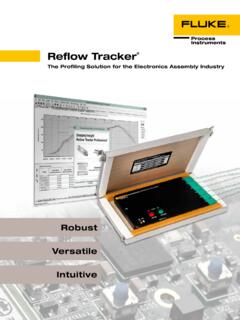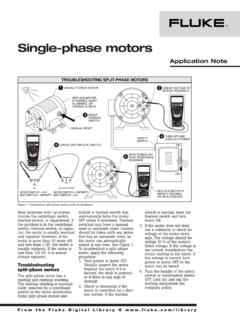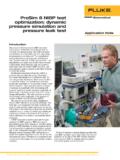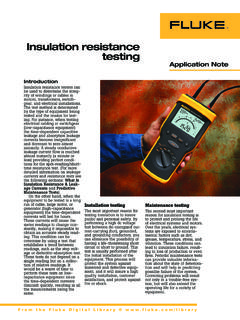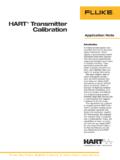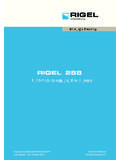Transcription of Measuring leakage currents in electromedical devices in ...
1 Measuring leakage currents in electromedical devices in accordance with IEC EN 62353. White Paper Vincenzo Ventimiglia, engineer, SLT srl Gianpetro Pellizzer, self-employed engineer Introduction The measurement of leakage currents in electro- medical devices and systems (hereinafter EM), in accordance with the IEC EN 62353:2010-10. Standard electromedical devices - Periodic checks and tests after repairs on electromedical devices , (hereinafter the Standard), provides for the use of three methods: direct, alternative and differential. The measurements to be performed are then classified into leakage current in the device and leakage currents in the parts applied, as defined in the Standard.
2 Where possible, the direct method is preferred, since it is more similar to the measurement ap- proach in the product standard IEC 60601-1-XX. We will indicate below the criteria for selecting the measurement method according to the mains supply characteristics and the installation condi- tions of the EM device or system. One of the most severe errors committed in the execution of electrical safety checks is to neglect Therefore, the variables in the leakage cur- the following fundamental aspects: rent measurement system are: type of system, EM. Failure to remove ground connections results in installation and measurement method.
3 Measurements generally equal to zero for the measured currents . A power supply from the isolation transformer Type of mains supply reduces the currents to negligible values be- The mains supply types, in order of importance cause the voltages on the two supply polarities for the purposes of periodic checking, are: are equal, and with opposite signs, compared to TN-S with four active distributed conductors the housing connected to ground. and voltage 400/230 V. A particular case to take into consideration is the TT with four active distributed conductors and existence, in some hospitals and in some parts of voltage 400/230 V.
4 The LV network, of a distribution system with only IT-M 230 V. three active distributed conductors and phase-to- TN-S with three active distributed conductors phase voltage of 230 V. (The neutral is not dis- and phase-to-phase voltage of 230 V. tributed and the power supply voltage of the EM TT with three active distributed conductors and devices or systems is 230 V phase/phase.) phase-to-phase voltage of 220 V. It should be noted, finally, that the same The TN-S system with four active distributed con- standard states if the power supply voltage of the ductors 400/230 V (Fig. 1) is generally present in device is U0 230 V, the values measured with all large public and private health care facilities.
5 The different methods must be multiplied by 230/ The TT system with four active distributed con- U0 to be more correctly compared with the limits ductors 400/230 V (Fig. 2) is generally present in indicated in the Standard. small public and private health care facilities that require less than approx. 100 kW. L1 The system of type IT-M (Fig. 3), with an isola- tion transformer, voltage 230 V and isolation detec- 400 V tor is required in all Group II medical rooms. L2 In some hospitals, the distribution is of the type 400 V. EM -TN-S with three active distributed conductors and 400 V phase-to-phase voltage of 230 V (Fig.)
6 4). L3 Some parts of the LV system are still managed with the TT system with three active distributed 200 V conductors and phase-to-phase voltage of 230 V. N. (Fig. 5). PE. Figure 1: Electrical diagram for -TN-S type system with four active distributed conductors and voltages of 400/230 V. L1 L1. EM. 400 V. 230 V 230 V. L2. 400 V L2. EM. 400 V. L3 230 V 133 V. L3. 200 V. N. 133 V. PE. PE PE. Figure 2: Electrical diagram for -TT type system with four Figure 4: Electrical diagram for -TN-S type system with three active distributed active distributed conductors and voltages of 400/230 V. conductors and phase-to-phase voltages of 230 V.
7 L1 L1. 400 V EM. L2 230 V 230 V. 400 V. TR 1:1 EM L2. 400 V. L3. 200 V. 200 V 230 V 133 V. N. L3. PE. 133 V. PE PE. Figure 3: Electrical diagram for IT-M system. Figure 5: Electrical diagram for -TT type system with three active distributed conductors and phase-to-phase voltages of 220 V. 2 Fluke Biomedical Measuring leakage currents in electromedical devices in accordance with IEC EN 62353. M. Type of installation and power supply The connection of the EM devices and systems to L1. their power supply can be: Movable single-phase/three-phase equipment AP. (with the possibility of being completely iso- L2. lated from the ground during the measurement).
8 With connection to the power supply through a plug/socket connection L3. Movable single-phase/three-phase equipment with permanent connection (without plug/. socket connection to the power supply) N. Fixed single-phase/three-phase equipment (which cannot be completely isolated from the ground during the measurement) with connec- tion to the power supply through a plug/socket PE. connection Fixed single-phase/three-phase equipment with permanent connection (without a plug/. socket connection to the power supply). Internal electrical power source. Figure 6: Electrical diagram for Measuring the leakage current in a three-phase EM device or system.
9 Measurement methods All three leakage current measurement methods Differential method required by the Standard are generally possible This leakage current measurement method for the with the Measuring instruments available in the device involves the use of a toroid traversed by market, but only for EM devices and EM systems all of the active conductors of the power supply with a single-phase power supply. With existing circuit of the EM device or EM system. The toroid instruments, it is possible to measure both the gives a signal proportional to the differential cur- equipment leakage current of the devices and the rent flowing through it.
10 Applied part leakage currents . EM devices with internal power source Direct method The leakage current in the device is not appli- Using the direct method, the device under test is cable to devices with an internal electrical power powered and the leakage currents are measured source. However, it is necessary to correctly from accessible parts and applied parts with measure the applied part leakage current if the interruption of the protective ground. The power applied part is floating. This will be discussed supply is then inverted between the two poles later. and the highest value is recorded. The Standard, and all of the electrical safety analyzers' user manuals, demonstrate the elec- Alternative method trical diagrams of the various measurement With the alternative method, the two ELM power methods.




